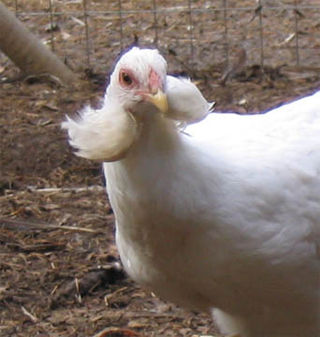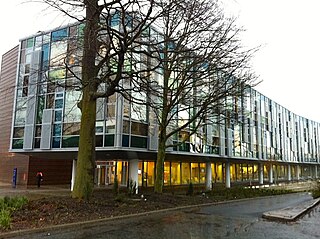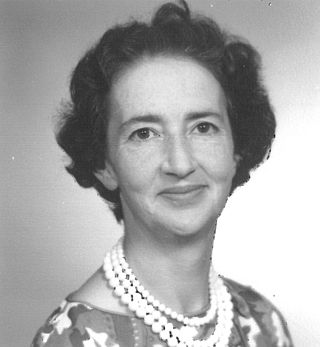Margaret M. Perry (1930-2009) was an English molecular geneticist and embryology researcher at the University of Edinburgh whose research produced the first warm-blooded animal developed completely in vitro. [1]
Margaret M. Perry (1930-2009) was an English molecular geneticist and embryology researcher at the University of Edinburgh whose research produced the first warm-blooded animal developed completely in vitro. [1]
Margaret Mary Perry was born in Stockton-On-Tees and educated at St Joseph's Catholic College in Bradford, where a headmistress had established a science laboratory. Perry's father was a civil engineer and her mother gained her degree from the University of Manchester in 1923. [1]
Perry graduated with a BSc in Pure Science (Genetics) from the University of Edinburgh in 1952. [2] She went on to work as a research assistant at the University's Institute of Animal Genetics and published research on the embryology of amphibians with the Institute's director C.H. Waddington. In 1975-76 she joined the Agricultural Research Council's Poultry Research Centre in Edinburgh, which later became part of the Roslin Institute. [3]
In 1988 Perry inserted foreign genetic material into single cell chicken embryos and cultured them to hatching "to produce the chick without its own egg shell", thus creating the first warm-blooded animal developed completely in vitro. [1] [4] [5] In 1993 Perry and Helen Sang collaborated to create the world's first genetically engineered cockerel by gene injection. [6] [7]
Perry spoke at a number of international conferences, including in Poland and Japan. She also worked in France on electron microscope techniques. [1]
After her retirement she visited Nepal, Australia, Egypt and the Galápagos Islands and walked frequently in the Highlands and Islands. [1]
Margaret Perry was a devout Catholic and regularly provided religious services to patients at the Royal Edinburgh Hospital and Astley Ainslie Hospital. She was a member of the St Vincent de Paul Society. [1]

Poultry are domesticated birds kept by humans for the purpose of harvesting animal products such as meat, eggs or feathers. The practice of raising poultry is known as poultry farming. These birds are most typically members of the superorder Galloanserae (fowl), especially the order Galliformes. The term also includes waterfowls of the family Anatidae but does not include wild birds hunted for food known as game or quarry.

The chicken is a large and round short-winged bird, domesticated from the red junglefowl of Southeast Asia around 8,000 years ago. Most chickens are raised for food, providing meat and eggs; others are kept as pets or for cockfighting.

The Araucana is a breed of domestic chicken from Chile. Its name derives from the Araucanía region of Chile where it is believed to have originated. It lays blue-shelled eggs, one of very few breeds that do so.

Breed broiler is any chicken that is bred and raised specifically for meat production. Most commercial broilers reach slaughter weight between four and six weeks of age, although slower growing breeds reach slaughter weight at approximately 14 weeks of age. Typical broilers have white feathers and yellowish skin. Broiler or sometimes broiler-fryer is also used sometimes to refer specifically to younger chickens under 2.0 kilograms, as compared with the larger roasters.

Ryuzo Yanagimachi was a Japanese-born, American-based scientist. He made numerous key contributions to the study of mammalian fertilization, and he was also a pioneer in the cloning field. Accordingly, he assisted in fertilization technologies such as in vitro fertilization and direct sperm injection into the egg, which are widely used today in human infertility clinics throughout the world. In 1997, his laboratory at the University of Hawaiʻi at Mānoa successfully cloned mice using the Honolulu technique.

Dame Anne Laura Dorinthea McLaren, was a British scientist who was a leading figure in developmental biology. She paved the way for women in science and her work helped lead to human in vitro fertilisation (IVF). She left an enduring legacy marked by her research and ethical contributions to the field. She received many honors for her contributions to science, including election as fellow of the Royal Society.
The Ixworth is an English breed of white domestic chicken. It is named for the village of Ixworth in Suffolk, where it was created in 1932. It was bred as fast-growing high-quality meat breed with reasonable laying abilities.

The Onagadori is a historic Japanese breed of chicken, characterised by an exceptionally long tail. It was bred in the seventeenth century in Kōchi Prefecture, on Shikoku island in southern Japan, and was designated a Japanese National Natural Treasure in 1952. It is one of the ancestors of the German Phoenix breed.

Cannibalism in poultry is the act of one individual of a poultry species consuming all or part of another individual of the same species as food. It commonly occurs in flocks of domestic hens reared for egg production, although it can also occur in domestic turkeys, pheasants and other poultry species. Poultry create a social order of dominance known as pecking order. When pressure occurs within the flock, pecking can increase in aggression and escalate to cannibalism. Cannibalism can occur as a consequence of feather pecking which has caused denuded areas and bleeding on a bird's skin. Cannibalism can cause large mortality rates within the flock and large decreases in production due to the stress it causes. Vent pecking, sometimes called 'cloacal cannibalism', is considered to be a separate form of cannibalistic pecking as this occurs in well-feathered birds and only the cloaca is targeted. There are several causes that can lead to cannibalism such as: light and overheating, crowd size, nutrition, injury/death, genetics and learned behaviour. Research has been conducted to attempt to understand why poultry engage in this behaviour, as it is not totally understood. There are known methods of control to reduce cannibalism such as crowd size control, beak trimming, light manipulation, perches, selective genetics and eyewear.

The Roslin Institute is an animal sciences research institute at Easter Bush, Midlothian, Scotland, part of the University of Edinburgh, and is funded by the Biotechnology and Biological Sciences Research Council.

The broiler industry is the process by which broiler chickens are reared and prepared for meat consumption. Worldwide, in 2005 production was 71,851,000 tonnes. From 1985 to 2005, the broiler industry grew by 158%.

Cryoconservation of animal genetic resources is a strategy wherein samples of animal genetic materials are preserved cryogenically.

Professor David Grainger Marcus Wood-Gush FRSE was a South African-born animal geneticist and ethologist based for most of his professional life in Edinburgh. He was an expert on animal behaviour and academic author in this field. He was one of the first to study the impacts of factory farming. He advocated the study of animal behaviour to gauge what implied "humane treatment" for different species, and tried to balance these factors against economic viability for the farmer. He looked at the impact of stress upon animals and held that animals should be treated as individuals not as a "commodity". In these studies he concluded that food supply was the essential factor in controlling animal behaviour.
Prof Frederick Bruce Hutt HFRSE was a Canadian zoologist and geneticist in the 20th century. His book Animal Genetics has 31 published editions from 1964 to 1981 and is translated into six languages.

Margaret Hurlstone Hardy Fallding was a developmental biologist in Australia and Canada who studied hair follicles.
The Yakido is a Japanese breed of fighting chicken. It belongs to the Shamo group of breeds. It was bred in the Kansai region in southern Honshu in the mid-nineteenth century. It was made a Natural Monument of Japan in 1950.
Margaret Frame is a British biologist. She is the Professor of Cancer Biology and Science Director of Cancer Research Centre at the University of Edinburgh. She is also Director of MRC Institute of Genetics & Molecular Medicine. She has made seminal contributions to understanding mechanisms of cell adhesion and motility. She previously served as deputy-director of the Beatson Institute in Glasgow.

Helen Mary Sang is the head of the Division of Developmental Biology at the Roslin Institute of the University of Edinburgh. Her research considers the development of chickens that cannot spread avian influenza. She has previously served on the Biotechnology and Biological Sciences Research Council.
Grahame Bulfield, CBE, FRSE, Hon FRASE is an English geneticist, vice-principal and Emeritus Professor of Genetics at the University of Edinburgh. He is best known as the former director and chief executive of the Roslin Institute, Edinburgh, when in 1996 the research group led by Ian Wilmut first cloned a mammal from an adult somatic cell, a Finnish Dorset lamb named Dolly.
Janet Scott Salmon Blyth was a Scottish geneticist who specialised in poultry genetics and husbandry in the interwar and post-war decades and played a prominent role in establishing the Poultry Research Centre, one of several institutions that would eventually be amalgamated to form the Roslin Institute.